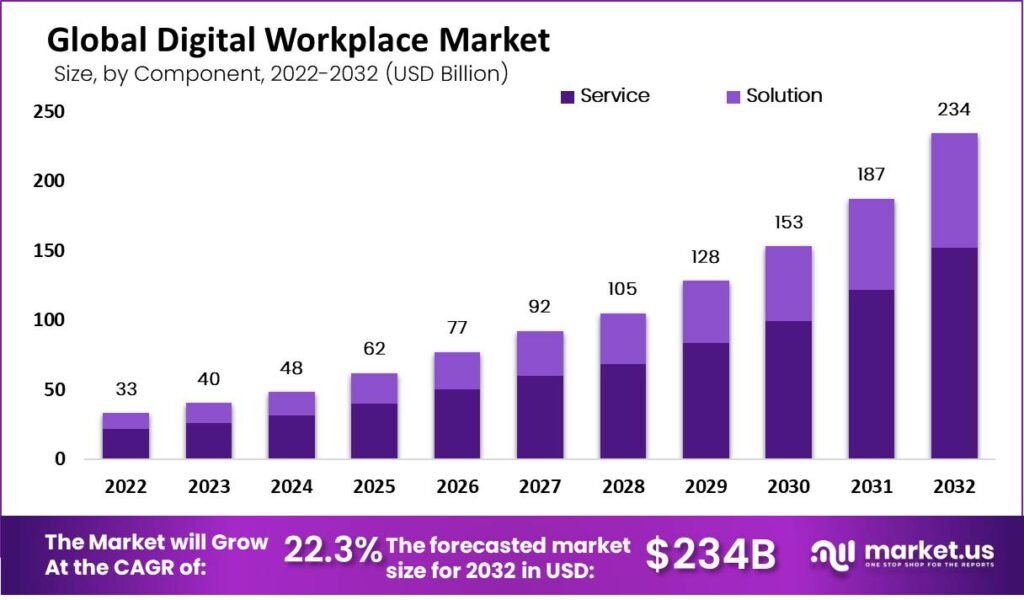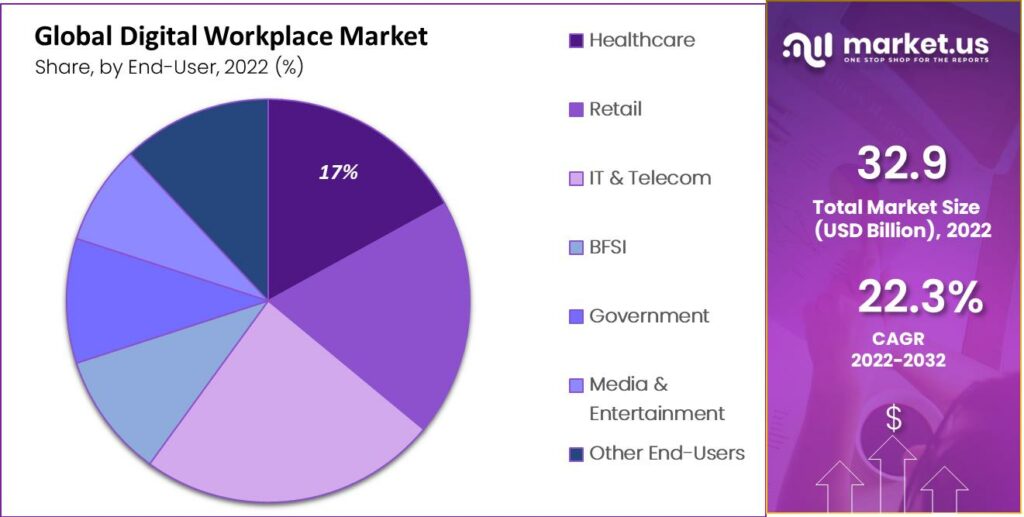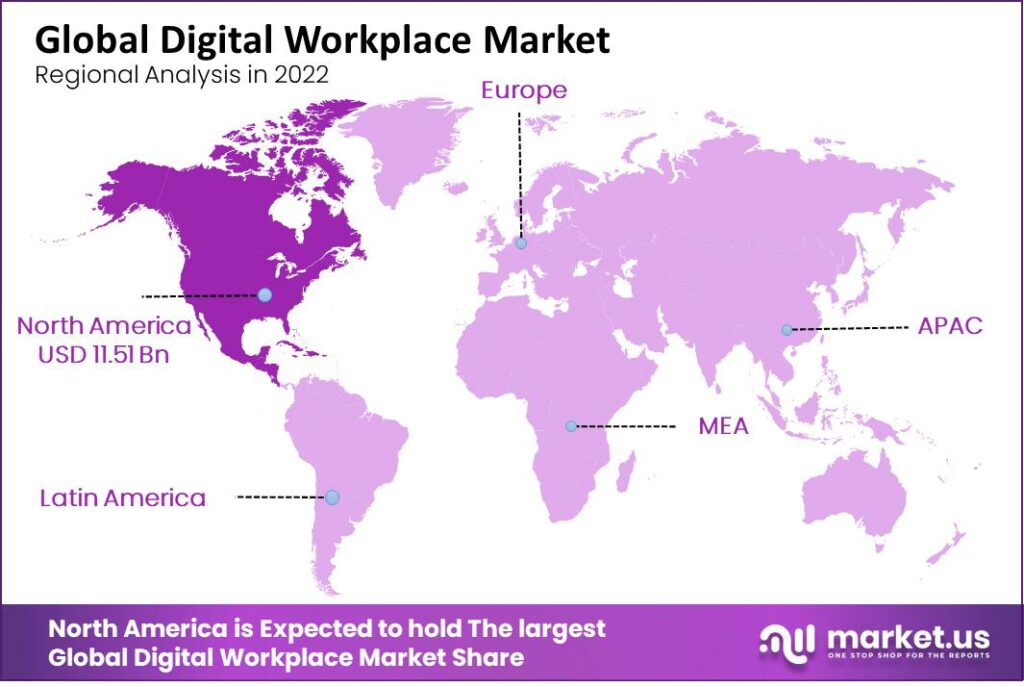Global Digital Workplace Market by Component (Solution and Services), By Enterprise Size (Small & Medium Enterprises and Large Enterprises), By End-Use, By Region and Companies - Industry Segment Outlook, Market Assessment, Competition Scenario, Trends, and Forecast 2023-2032
- Published date: Oct. 2023
- Report ID: 42682
- Number of Pages: 293
- Format:
- keyboard_arrow_up
Quick Navigation
Report Overview
In 2023, the global digital workplace market was valued at USD 40 billion and is expected to reach USD 234 billion in 2032. This market is estimated to register a CAGR of 22.3% between 2023 and 2032.
The digital workplace is the modern version of traditional workplaces, offering customized role-based services to employees. Employees can easily access data and services from anywhere at any time to meet their requirements. A digital workplace utilizes the latest services and technology to adjust to how people work, increasing employee engagement and satisfaction levels. It provides a personal environment, that enables workers to do their jobs more efficiently from home or other remote locations. Instead of being constrained by technology, people become motivated by it, leading them to reach their highest potential.

Note: Actual Numbers Might Vary In The Final Report
Digital workplace services can assist businesses to reduce operating expenses, as they no longer need to pay rent for office spaces or electricity bills. Additionally, the combination of mobile devices and cloud-based applications has drastically changed our work environments into cooperative open spaces with non-routine schedules as the new norms.
Key Takeaways
- Robust Growth: The digital workplace market is projected to expand significantly, with a CAGR of 22.3% from 2023 to 2032, reaching a valuation of USD 234 billion.
- Driving Forces: Factors such as cloud technology adoption, remote work demand, mobile device integration, focus on employee productivity, and technological advancements are propelling market growth.
- Market Dynamics: Implementation costs, lack of digital skills, data security concerns, integration challenges, and resistance to change are some of the factors hindering the market’s full potential.
- Dominant Segments: Services hold a 65% market share, while large enterprises contribute 63% due to their adoption of advanced technologies.
- Leading Sectors: IT & Telecom command a 24% market share, driven by IoT, AI, and work-from-home trends, exemplified by Infosys’ successful implementation of digital workspace platforms.
- Growth Opportunities: Enhanced collaboration, remote work facilitation, personalized experiences, task automation, and data-driven insights present avenues for market expansion.
- Current Trends: Hybrid work models, AI-powered automation, employee experience prioritization, cybersecurity measures, and seamless integration are defining trends in the digital workplace market.
- Regional Dynamics: North America leads with a 35% market share, fueled by AI and enterprise mobility, while the Asia Pacific region shows promise with a projected CAGR of 23.6%, driven by rapid digitization.
- Key Players: Major market players like IBM, Accenture, and Infosys are actively investing in research and development, mergers, and partnerships to advance their product offerings and secure a competitive edge.
Driving Factors
- Increased Adoption of Cloud-Based Technologies: As cloud adoption increases, organizations are transitioning from traditional workplaces to digital ones. The cloud offers greater adaptability, scalability, and accessibility which makes it simpler for businesses to implement digital workplaces.
- Growth of Remote Work Demand: The COVID-19 pandemic has seen a marked shift towards remote work, which is expected to persist even after the crisis ends. As such, there has been an uptick in demand for digital workplace solutions that facilitate this type of arrangement and collaboration.
- Rise of Mobile Devices: Mobile devices are becoming more prevalent in the workplace, with employees increasingly using them to access work-related information and applications. This has necessitated a need for digital workplace solutions that are optimized for mobile use.
- Focus on Employee Engagement and Productivity: Companies are realizing the significance of employee engagement and productivity for driving business success. Digital workplace solutions can facilitate better collaboration, communication, and knowledge sharing among employees – leading to higher levels of engagement and productivity.
- Advancements in Technology: Emergencies such as artificial intelligence, machine learning, and the Internet of Things (IoT) are enabling more sophisticated digital workplace solutions. These innovations make it simpler to automate repetitive tasks, provide personalized experiences and enhance decision-making processes.
Restraining Factors
- Cost of Implementation: Adopting a digital workplace solution can be costly, particularly for small and medium-sized enterprises (SMEs). This may present as an impediment to adoption for some organizations.
- Lack of Digital Skills: While digital workplaces offer numerous advantages, they require a certain level of digital literacy and proficiency to use effectively. Without adequate skillsets or training, some employees may lack the capacity to utilize these solutions effectively, leading to lower adoption rates.
- Data Security Concerns: As digital workplaces involve storing and sharing sensitive information, data security should be a top priority. Organizations must guarantee their digital workplace solutions have robust security features to guard against cyber threats.
- Integration Challenges: Integrating digital workplace solutions with existing systems and processes can be a formidable obstacle, particularly for organizations that rely on legacy systems. This could negatively affect the usability and efficacy of these solutions.
- Resistance to Change: Transitioning from a traditional workplace to a digital one can be intimidating for some employees, leading to resistance. Organizations need to effectively communicate the advantages of digital workspaces to employees and offer adequate training in order to help them adjust.
By Component Analysis
By The Component Analysis, The Services Segment Dominates The Market With a 65% Market Share.
Most Small to Medium-Sized Enterprises (SMEs) have adopted cloud-based technology and leverage modern, cloud-oriented, and qualified insights, along with artificial intelligence, IoT, Cloud computing, and other industrial automation mechanizations. Large organizations benefit from executive and professionally managed services; ultimately these services increase demand for the digital workplace.
By Enterprise Size Analysis
By Enterprise Size Analysis, The Large Enterprise Segment Dominates The Market With A 63% Market Share.
Cloud technology, cutting-edge software, and tools are being adopted by large enterprises. These tools are simple to use and are powered by AI. Tata Consultancy Services Limited’s (TCS) Cognix, a digital workspace with full automation features, is an example of this. The solution offers real-time dashboards and intelligent reporting. It also equips users with future technologies, such as Augmented Reality(AR), Virtual Reality(VR), or cognitive automation. These solutions will accelerate the adoption and use of digital workplaces within large companies.
By End-User Analysis
By the End-User Analysis, IT And Telecom Dominate The Market With a 24% Market Share.
In the IT and telecom sector, there is growing adoption of IoT, AI, SaaS, work-from-home culture, and bring-your-own-device (BYOD), which have led to more digital workstation apps. Infosys is an IT company offering business consulting and outsourced services.
They have recently implemented four digital workspace platforms for their employees: Launchpad (for onboarding of new employees), InfyMe, (for employee service and experience platform), LEX, (for digital learning), and Meridian, (for virtual events and collaboration). Infosys was able to adapt hybrid and remote work models quickly during the pandemic. This innovation will further drive the adoption of digital workplaces within IT & Telecom during the forecast period.

Note: Actual Numbers Might Vary In The Final Report
Key Market Segments
Based on Component
- Services
- Solutions
Based on Enterprise Size
- Small and Medium Enterprises
- Large Enterprises
Based on End-User
- Healthcare
- Retail
- IT & Telecom
- BFSI
- Government
- Media & Entertainment
- Other End-Users
Growth Opportunity
- Increased Collaboration: Digital workplace solutions offer tools for real-time collaboration, communication, and knowledge sharing among employees. Fostering a collaborative work environment can improve decision-making, expedite problem-solving processes and promote innovation within organizations.
- Remote Work: As more employees opt for remote work, organizations have an opportunity to leverage digital workplace solutions to facilitate and support this trend. By giving employees the necessary tools for successful remote work, businesses can attract and retain top talent while improving overall productivity.
- Personalization: Digital workplace solutions can be tailored to each employee’s requirements, creating a more tailored experience. Organizations that understand employee preferences and work styles will see improvements in engagement levels, productivity levels, and job satisfaction scores.
- Automation: Recent advances in artificial intelligence and machine learning are allowing routine tasks to be automated, freeing employees to focus on more strategic, high-value work. Digital workplace solutions that incorporate automation can help organizations boost efficiency and reduce expenses.
- Data-Driven Insights: Digital workplace solutions generate vast amounts of data about employee behavior, productivity, and engagement. By analyzing this information, organizations can gain invaluable insights into their workforce and identify areas for improvement.
Latest Trends
- Hybrid Work: With the COVID-19 pandemic, hybrid work has gained momentum. This type of arrangement involves combining remote and on-site activities, necessitating digital workplace solutions that can seamlessly support both modes of employment.
- AI-Powered Automation: Artificial intelligence (AI) is becoming increasingly integrated into digital workplace solutions, automating repetitive tasks and providing insights to enhance productivity and employee experience.
- Employee Experience: Organizations are placing increasing emphasis on employee experience, and digital workplace solutions are being designed to offer a tailored and engaging experience for workers.
- Cybersecurity: With digital workplaces involving sensitive data storage and sharing, cybersecurity has become an increasingly critical concern. To combat this threat, digital workplace solutions are being designed with robust security features to safeguard against potential breaches.
- Integration and Interoperability: Digital workplaces necessitate the seamless integration of various systems and applications, so interoperability is becoming an increasingly important factor. Solutions that can easily link with existing programs and infrastructure are becoming increasingly sought-after.
- Digital Transformation: Digital transformation is a major trend driving the adoption of digital workplace solutions. Organizations are increasingly looking to digitize their operations and processes, with these solutions playing an essential role in this process.
Regional Analysis
By The Regional Analysis, North America Dominates The Market With a 35% Market Share.
Digital workplaces have seen a remarkable increase in growth thanks to the adoption of new technologies such as AI, BYOD, and enterprise mobility solutions. Cloud technologies and Artificial Intelligence are being rapidly integrated into the service offerings of many regional workplace transformation providers. IBM Talent & Transformation was unveiled in May 2020. This business solution leverages AI and helps human resources to bridge the skills gap.
This solution empowers professionals in various fields, such as HR and legal, finance, and marketing, to embrace digital technologies. A bustling manufacturing sector, retail, and automotive industry in the region also encourage a preference for software and robotics. The growth of the market is a result. Asia Pacific will experience a CAGR, of 23,6%, during the forecast period. This is due to the rapid digitization of various industries and the increasing reliance of enterprises on cloud platforms. Market players in the region also employ various strategies, such as collaborations and strategic partnerships, to maintain dominance in the industry.

Note: Actual Numbers Might Vary In The Final Report
Key Regions and Countries Covered in this Report:
- North America
- The US
- Canada
- Europe
- Germany
- France
- The UK
- Spain
- Italy
- Russia
- Netherland
- Rest of Europe
- APAC
- China
- Japan
- South Korea
- India
- Australia
- New Zealand
- Singapore
- Thailand
- Vietnam
- Rest of APAC
- Latin America
- Brazil
- Mexico
- Rest of Latin America
- Middle East & Africa
- South Africa
- Saudi Arabia
- UAE
- Rest of MEA
Key Players Analysis
Accenture, Capgemini, and IBM are the leading players in this market. Infosys, Tata Consultancy Services Limited, Trianz, and Tata Consultancy Services Limited also play a major role. These key players invest in research and development to support growth and improve their internal business operations. These companies also take part in mergers and acquisitions, as well as partnerships, to improve their products further and gain an advantage. Companies are working actively on product improvement and new product development to attract new customers and increase market share.
Market Key Players
- IBM Corporation
- Accenture plc
- Atos SE
- Trianz
- Capgemini
- HCL Technologies Limited
- Infosys Limited
- Tata Consultancy Services Limited
- Tech Mahindra Limited
- Mphasis
- Other Key Players
Recent Developments
- On February 20, 2021, Accenture announced the acquisition of Imagine – a provider of cloud-based platforms. This acquisition will enable Accenture to enhance its offering of cloud-based management for digital solutions and services.
- In 2020, IBM created a revolutionary line setup that utilizes artificial intelligence (AI) to aid HR professionals in perfecting their professional techniques.
- In February 2020, Infosys announced its partnership with GE Appliances. Through this alliance, Infosys will assist GE in further developing its IT framework and function IT in managed services.
Report Scope
Report Features Description Market Value (2023) USD 40 Bn Forecast Revenue (2032) USD 234 Bn CAGR (2023-2032) 22.3% Base Year for Estimation 2022 Historic Period 2016-2022 Forecast Period 2023-2032 Report Coverage Revenue Forecast, Market Dynamics, COVID-19 Impact, Competitive Landscape, Recent Developments Segments Covered by Component (Solution and Services), By Enterprise Size (Small & Medium Enterprises and Large Enterprises), By End-Use Regional Analysis North America – The U.S. & Canada; Europe – Germany, France, The UK, Spain, Italy, Russia, Netherlands & Rest of Europe; APAC- China, Japan, South Korea, India, Australia, New Zealand, Singapore, Thailand, Vietnam & Rest of APAC; Latin America- Brazil, Mexico & Rest of Latin America; Middle East & Africa- South Africa, Saudi Arabia, UAE & Rest of MEA Competitive Landscape IBM, Accenture plc, Atos SE, Trianz, Capgemini, HCL Technologies Limited, Infosys Limited, Tata Consultancy Services Limited, Tech Mahindra Limited, Mphasis Customization Scope Customization for segments, region/country-level will be provided. Moreover, additional customization can be done based on the requirements. Purchase Options We have three licenses to opt for: Single User License, Multi-User License (Up to 5 Users), Corporate Use License (Unlimited User and Printable PDF) Frequently Asked Questions (FAQ)
What will be the market size for Digital Workplace Market in 2032?In 2032, the Digital Workplace Market will reach USD 234 billion.
What CAGR is projected for the Digital Workplace Market?The Digital Workplace Market is expected to grow at 22.3% CAGR (2023-2032).
Name the major industry players in the Digital Workplace Market.IBM Corporation, Accenture plc, Atos SE, Trianz, Capgemini, HCL Technologies Limited, Infosys Limited and Other Key Players are the main vendors in this market.
List the segments encompassed in this report on the Digital Workplace Market?Market.US has segmented the Digital Workplace Market Market by geographic (North America, Europe, APAC, South America, and MEA). By Component, market has been segmented into Solutions and Services. By Enterprise Size, the market has been further divided into Small and Medium Enterprises and Large Enterprises.

- IBM Corporation
- Accenture plc Company Profile
- Atos SE
- Trianz
- Capgemini SE Company Profile
- HCL Technologies Limited
- Infosys Limited
- Tata Consultancy Services Limited
- Tech Mahindra Limited
- Mphasis
- Other Key Players
- settingsSettings
Our Clients
| Single User $4,599 $3,499 USD / per unit save 24% | Multi User $5,999 $4,299 USD / per unit save 28% | Corporate User $7,299 $4,999 USD / per unit save 32% | |
|---|---|---|---|
| e-Access | |||
| Report Library Access | |||
| Data Set (Excel) | |||
| Company Profile Library Access | |||
| Interactive Dashboard | |||
| Free Custumization | No | up to 10 hrs work | up to 30 hrs work |
| Accessibility | 1 User | 2-5 User | Unlimited |
| Analyst Support | up to 20 hrs | up to 40 hrs | up to 50 hrs |
| Benefit | Up to 20% off on next purchase | Up to 25% off on next purchase | Up to 30% off on next purchase |
| Buy Now ($ 3,499) | Buy Now ($ 4,299) | Buy Now ($ 4,999) |















